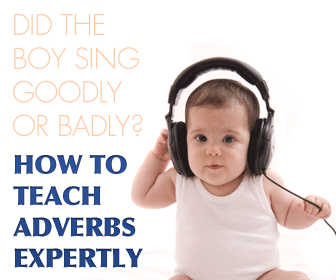
Teaching adverbs doesn’t have to be as complicated as everyone seems to think.
The basic instruction of them is pretty simple, but it does get more complicated when you are looking at more grammatically based uses of adverbs. Taking the simple approach in teaching and reinforcing adverbs will quickly help you teach them expertly. Here are some thing to keep in mind when coming face to face with adverbs.
How to Teach Adverbs Expertly
-
1
Grammar First, Fun Second
Get the grammar straight with the students first and then jump into all the fun practice activities you have planned. Initial grammar is pretty simple. Here are the basics:
- - Adverbs can modify a verb, an adjective, or another adverb.
- - Many adverbs end with -ly so sometimes they are easy to see.
- - You can make adverbs by adding -ly to the end of an adjective. For example, Loudly, Quickly, Wonderfully, etc.
Come up with lists of adjectives they can change into adverbs and discuss how adverbs can make descriptions more vivid and can provide more detail. It can be fun to practice how someone does something and it will generate a lot of new words and new questions. You can also get quite animated while practicing adverbs and have students act out how they do things (sadly, quietly, quickly, loudly, etc.).
-
2
Use How, When, and Where as Your Go To Questions
Adverbs most often answer the questions How? or When? How did he sing? Nicely, badly, wonderfully, etc.
- The boy sang so nicely it made me want to cry.
That is a much better description than the boy is a good singer. Adverbs do not always end in –ly and many times when they don’t they are either an exception or they are answering the question when or where.When did he start school? He started school yesterday. You can start out with vocabulary the students know already, like today, tomorrow, sometimes, rarely, downstairs, etc. and practice placing them correctly in sentences. Don’t get too far into the deep grammar until students are at a more intermediate level. Give explanations and practice in chunks and then review each of the pieces separately.
-
3
Teach the Exceptions Before it Comes Up
The most confusing adverbs are the exceptions. Most native speakers are still confused by good and well. Well is the adverb, but the confusing thing is that we misuse good all over the place--so much so that to us, using well doesn’t sound right! Students may have lots of questions about good vs. well and you can provide them with good examples.
- You cannot do something goodly—but you can do it well.
- When you are sick you don’t feel well, not good.
- When asked How are you? You should say I am well, not I am good (short for I am doing good).
This may come up again and again since students will hear it spoken incorrectly most of the time. -
4
What is it Modifying?
The most confusing part about teaching adverbs is to introduce the other modifiers. An adverb can modify a verb, an adjective, or another adverb.
For example:- - Verb Modification: I speak fluently.
- - Adjective Modification: The girl is very happy.
- - Adverb Modification: The boy is almost always rude.
It is good to make sure they understand these three basic adverbial concepts and to add more depth to your explanations as you see fit. Practice of Adverbs of Frequency is always a good way to remind the students that adverbs have different uses and different placements depending on what they are modifying. You can show diagrams of sentences with several different adverbs and have the students tell you what each adverb is modifying.
Take your time when explaining adverbs. The best way to make sure they get it all straight is to teach the modifiers at separate times and practice each one in a lot of different ways.
Teaching adverbs can become quite involved but if you follow these tips your students will be using them expertly in no time.
P.S. If you enjoyed this article, please help spread it by clicking one of those sharing buttons below. And if you are interested in more, you should follow our Facebook page where we share more about creative, non-boring ways to teach English.








